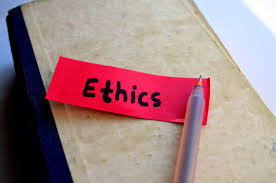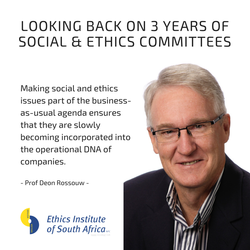 What does a flashmob and industrial theatre have to do with building ethical organisations? According to some speakers at the 5th annual ethics conference held on 18 May at Gallagher Convention Centre, it is alternative creative approaches that will get the message of the importance of ethical conduct across. To build an ethical organisation, four key groups of stakeholders need to be persuaded that ethics is good business and needs to be integrated into how an organisation and its partners go about their daily business. Conventional methods of persuasion like training and giving speeches need to be complemented by others that are potentially more impactful, such as singing, humour and industrial theatre. “When one is building a genuinely ethical organisation, drafting policies and codes is only the first step. Then begins the long business of persuading these four key stakeholder groups—leadership, employees, supply chain partners and industry peers—to buy into ethics,” says Professor Deon Rossouw, CEO of the Ethics Institute of South Africa (EthicsSA), host of the event. Conference delegates were treated to a flashmob and a piece of industrial theatre that showed just how effective alternative interventions could be. Johan van Zyl, Group CEO at Sanlam argued strongly that the process of building an ethical organisation has to begin at the top, beginning with the board, which has to commit publicly to ethics above the pursuit of short-term profits. Tolerance for deviation from the company’s ethical code has to become less and less the higher up the organisational structure it occurs, Dr Van Zyl said. Building an ethical organisation is first and foremost a top-down process. As was made clear in a subsequent panel discussion introduced by Professor Shirley Zinn, that while the “tone at the top” is vital, it also needs to become the “tune in the middle”. Ethical standards must become an integral part of how the organisation does business. Brian Leroni, Group Corporate Affairs Executive at Massmart, made the case for bringing the supply chain on board as well. He noted how deeply a company could be embarrassed—and worse—by the unethical behaviour of members of its supply chain. Some companies who have outsourced all or part of their manufacturing to the Far East have already experienced some of the negative effects of unethical practices by suppliers. However, Leroni emphasised how difficult and lengthy such a process was, and warned that big companies needed to act ethically when undertaking it. Like other stakeholders, suppliers have to be persuaded that ethics make for good business, and not simply bullied into it—in itself an unethical action, after all. Sabine Dall’Omo, CEO of Siemens South Africa, addressed the fourth group of stakeholders, a company’s industry peers. Collective action is essential particularly in industries in which there are entrenched corrupt practices and, consequently, a dramatically uneven playing field. Dall’Omo shared the hard lessons Siemens itself learned by letting itself become complicit in such practices. “All the speakers emphasised the need for both creativity and perseverance in persuading these and other stakeholder groups to buy into the organisation’s ethical standards—but they also stressed the benefits to be gained. Being ethical means fewer sleepless nights but, even, more to the point, improved business performance and results,” Professor Rossouw concludes. ENDS MEDIA CONTACT: Juanita Vorster, 079 523 8374, [email protected], www.atthatpoint.co.za For more information on EthicsSA please visit: Website: www.ethicssa.org LinkedIn: Ethics Institute of South Africa Facebook: Ethics Institute of South Africa
0 Comments
Building credibility for the sustainability agenda Three years ago on 1 May, the requirement in the new Companies Act for social and ethics committees came into effect. It’s probably not an exaggeration to say that confusion reigned at the time. The Act and its enabling regulations were just not clear, and peoples’ aversion to change was complicated by genuine bewilderment. So great was the confusion that EthicsSA and the Institute of Directors in Southern Africa began running workshops to help companies get a handle on this new concept. Perhaps the biggest achievement of this new committee is that sustainability issues are now a regular board agenda item. Most social and ethics committees have settled into a rhythm of meeting prior to scheduled board meetings, and their reports are tabled at the subsequent board meeting. As a result, sustainability issues have become a regular subject for top-level discussion and scrutiny. It is impossible to overestimate the long-term impact this is having—by making social and ethics issues part of the business-as-usual agenda, they are slowly becoming incorporated into the operational DNA of companies. A related achievement is that because these issues are being thought about and reported on regularly, the sustainability and integrated reports are becoming much more credible and useful. In truth, many of these reports were put together in a hurry and did not necessarily reflect what truly went on. But when management has to report regularly on these issues, the content of the sustainability report is generated by institutional processes, and thus better reflects what happened. However, it needs to be noted that there remain a number of challenges to be overcome. First, the inexact and incomplete legislation and regulations continues to cause confusion. Legally, the position is still that the committee has only a social mandate. Leading companies have used King III as their guide and have incorporated ethics, but this is purely voluntary. It is to be hoped that this omission is rectified by legislators soon. A structural challenge is the fact that the mandates of social and ethics committees can overlap with other board committees, such as audit, HR and remuneration. These overlaps need to be addressed to prevent a “turf war” from developing. A more difficult challenge is the fact that most companies are still grappling with how to produce the right content and quality of reports for the social and ethics committee. Committee members tend to be non-executive, so do not have the inside knowledge to be able to assess the reporting, whereas managers are often uncertain about what needs to be reported. A contributing factor is surely the lack of performance indicators for social and ethics issues, which also means it is hard for all parties to move beyond compliance to assessing the impact of social and ethics performance. This expectation gap causes frustration all round. Based on EthicsSA’s interaction with hundreds of companies at various training sessions, our overwhelming conclusion is that the key success factor is a social and ethics committee whose agenda is closely aligned with the company strategy. This breathes energy into the committee’s operations because members can see the strategic importance of what they are doing, and the board and executive management can see that the company is deriving real value from the work done by the social and ethics committee. For example, as we have seen, a mine’s long-term sustainability is dependent on its relationship with the surrounding community and its employees—exactly the sort of area for which the social and ethics committee takes responsibility. To paraphrase, don’t ask what you can do for your social and ethics committee, but what it can do for you. If the committee is seen to be delivering value, it will continue to improve, creating a genuine virtuous cycle. ENDS MEDIA CONTACT: Juanita Vorster, 079 523 8374, [email protected], www.atthatpoint.co.za For more information on EthicsSA please visit: Website: www.ethicssa.org LinkedIn: Ethics Institute of South Africa Facebook: Ethics Institute of South Africa |
Welcome to the newsroom of The Ethics Institute. For media releases prior to August 2014 please click here.
Archives
August 2017
Categories
All
|

 RSS Feed
RSS Feed